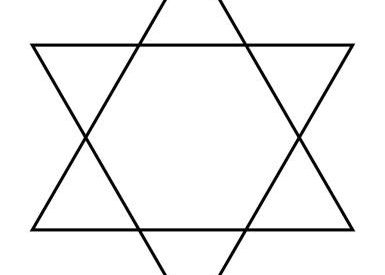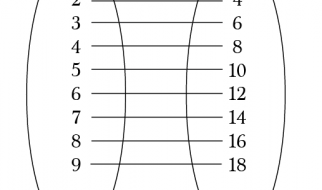The Triangle
The triangle symbol is a simple one, but is also one with a great amount of meaning behind it.
Due to the fact that triangles contain three corners and three sides they are often linked to different trinities. The most common being that of the Christian faith, the holy trinity- father, son and Holy Ghost. The triangle can also symbolize the stages of the moon- waxing, waning and full. Other trinities include: mind, body & spirit; mother, father & child; past, present & future; mother, maiden & crone; thought, feeling & emotion and creation, preservation and destruction.
Another Christian symbol incorporating triangles of that of the ?Eye of Providence? or the all-seeing eye. This is depicted as an eye inside a triangle and is often surrounded by rays of light.
In Celtic culture the triangle is featured in the form of the triquetra, triskelion as well as other trinity based knot work.
To the Greeks, the triangle is seen as the delta glyph and is symbolic of a doorway. The thought was that the combination of polarities would provide a new opening, balancing thought and emotion would provide a doorway to higher wisdom (the hypotenuse).
Mystic teachings also incorporate the power of three. Numerologically speaking, if one represents force, two represents an opening, then three is the birthing of wisdom. This is also said to represent the union of one and two.
The meaning of the triangle can vary based on their orientation. None of the other basic shapes offer this kind of inherent duplicity. When we turn a square on its side, the symbol meaning remains the same. Same with the circle ? rolling it around, it?s still a circle.
But the triangle proposes mammoth (polar even) variables in meanings when tipped top from bottom.
If a triangle is positioned pointing upwards it symbolizes the following: masculinity, solar, Shakta, active, assertive, up and father. When flipped upside down it represents the feminine, Shakti, passivity, down, mother, lunar and cave.
A triangle tattoo can also symbolize creativity, harmony, ascension, proportion, manifestation, integration, culmination and change.
Triangles are found in ancient symbolism and runes dating back to the earliest civilizations. Below I will outline some of the well known symbols containing triangles that have been found by archaeologists all over the world.
 The Dragon?s Eye
The Dragon?s Eye
The Dragon?s Eye is an ancient Germanic symbol as collected by Rudolf Koch. The Dragon?s Eye is an isosceles or equilateral triangle pointing downward, with a ?Y? in the middle connecting the three points of the triangle together. According to Carl G. Liungman?s Dictionary of Symbols, it combines the triangle meaning threat and the ?Y? meaning a choice between good and evil.
The dragon?s eye is a well known symbol of protection, said to protect anyone who recited the incantation to it. The dragon is a universal motif linked to various cultures of humanity for 5,000 years. The word dragon comes from ?derkesthai? (Greek: to glance dartingly) which, in a Hindu tradition, was the hungry look of the very first being when its fiery spirit was born out of the abyss of water. The Dragon?s Eye symbol stands for the balance of love, power and wisdom. Triple triangles are associated with the Goddess and the nine Muses.
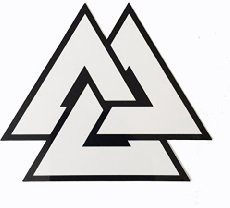 The Valknut
The Valknut
The Valknut (pronounced ?VAL-knoot?) is one of the most widely-discussed yet enigmatic of all of the symbols that appear in connection with Norse mythology. Visually, it?s comprised of three interlocking triangles. Archaeologically, it appears on several runestones and pictorial memorial stones that date from the Viking Age and stand on the Swedish island of Gotland, as well as on grave goods from the Oseberg ship burial in Norway. Its name isn?t mentioned in any period sources; valknut is a modern Norwegian compound word that means ?knot of those fallen in battle? and was introduced by Norwegians who lived long after the Viking Age.
In the archaeological record, the Valknut appears only in connection with the cult of the dead, as in the aforementioned runestones and ship burial. Similar-looking symbols can also be found on the cremation urns of the Anglo-Saxons,another Germanic people closely related to the Norse linguistically, ethnically, and in terms of their pre-Christian worldview and religion.
In most of these cases, Odin is also present. Even in instances where he?s not present directly alongside the Valknut, we often find other symbols that are closely associated with him. For example, the Anglo-Saxon urns feature depictions of horses and wolves, two animals that are often the companions of Odin in the Norse mythological tales.
So, given the present state of our knowledge, we can reasonably assume that the meaning of the Valknut has much to do with death, the transition from life to death and probably back again, Odin, and the power to bind and unbind.
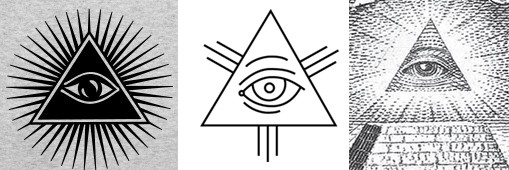 The Eye of Providence
The Eye of Providence
The Eye of Providence (or the all-seeing eye of God) is a symbol showing an eye often surrounded by rays of light or a glory and usually enclosed by a triangle. It represents the eye of God watching over mankind (or divine providence) The association of an eye with the concept of Divine Providence did not emerge until well into the Christian Era, in Renaissance European iconography, where it was an explicit image of the Christian Trinity. Seventeenth-century depictions of the Eye of Providence sometimes show it surrounded by clouds or sunbursts.
In 1782, the Eye of Providence was adopted as part of the symbolism on the reverse side of the Great Seal of the United States. It was first suggested as an element of the Great Seal by the first of three design committees in 1776 and is thought to be the suggestion of the artistic consultant, Pierre Eugene du Simitiere.[5]
In his original proposal to the committee, Du Simitiere placed the Eye over shields symbolizing each of the original thirteen states of the Union. On the version of the seal that was eventually approved, the Eye is positioned above an unfinished pyramid of thirteen steps (again symbolizing the original States, but incorporating the nation?s potential for future growth). The symbolism is explained by the motto that appears above the Eye: Annuit C?ptis, meaning ?[Providence] approves (or has approved) [our] undertakings?.[6]
Today, the Eye of Providence is often associated with Freemasonry. The Eye first appeared as part of the standard iconography of the Freemasons in 1797, with the publication of Thomas Smith Webb?s Freemasons Monitor.[7] Here, it represents the all-seeing eye of God and is a reminder that man?s thoughts and deeds are always observed by God (who is referred to in Masonry as the Great Architect of the Universe). Typically, the Masonic Eye of Providence has a semi-circular glory below the eye. Sometimes the Eye is enclosed by a triangle.
Popular among conspiracy theorists is the claim that the Eye of Providence shown atop an unfinished pyramid on the Great Seal of the United States indicates the influence of Freemasonry in the founding of the United States. However, common Masonic use of the Eye dates to 14 years after the creation of the Great Seal. Furthermore, among the members of the various design committees for the Great Seal, only Benjamin Franklin was a Mason (and his ideas for the seal were not adopted). Indeed, many Masonic organizations have explicitly denied any connection to the creation of the Seal.
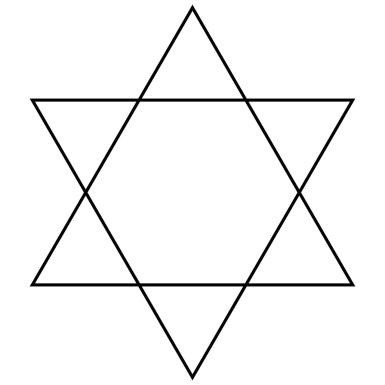 The Hexagram
The Hexagram
The hexagram is a mandala symbol called satkona yantra or sadkona yantra found on ancient South Indian Hindu temples. It symbolizes the nara-narayana, or perfect meditative state of balance achieved between Man and God, and if maintained, results in ?moshka,? or ?nirvana? (release from the bounds of the earthly world and its material trappings).
Some researchers have theorized that the hexagram represents the astrological chart at the time of David?s birth or anointment as king. The hexagram is also known as the ?King?s Star? in astrological circles.
In antique papyri, pentagrams, together with stars and other signs, are frequently found on amulets bearing the Jewish names of God, and used to guard against fever and other diseases. Curiously the hexagram is not found among these signs. In the Greek Magical Papyri[citation needed] (Wessely, l.c. pp. 31, 112) at Paris and London there are twenty-two signs side by side, and a circle with twelve signs, but neither a pentagram nor a hexagram.
The Magen David is a generally recognized symbol of Judaism and Jewish identity and is also known colloquially as the Jewish Star or ?Star of David.? Its usage as a sign of Jewish identity began in the Middle Ages, though its religious usage began earlier, with the current earliest archaeological evidence being a stone bearing the shield from the arch of a 3?4th century synagogue in the Galilee.[11] A more enduring symbol of Judaism, the menorah, has been in use since BC according to the Torah Exodus 25:31?40
Now that you know the history and importance of triangles, slow down and take time to notice the shape in nature and in your every day life.
Below are some additional meanings.
- Gender
- Creativity
- Harmony
- Proportion
- Ascension
- Culmination
- Illumination
- Integration
- Subjectivity
- Manifestation
Historical and Cultural Trinities Represented by the Triangle
- Waxing, Waning, Full
- Spirit, Mind, Body
- Father, Son, Holy Ghost
- Mother, Father, Child
- Past, Present, Future
- Power, Intellect, Love
- Thought, Feeling, Emotion
- Mother, Maiden, Crone
- Love, Truth, Wisdom
- Creator, Destroyer, Sustainer
- Creation, Preservation, Destruction
REFERENCES
1. ?The eye as a Christian symbol?. catholic-saints.com.
2. ?The Eye as a religious symbol?. Religiousfacts.com.
3. ?Freemasonry and the All-seeing Eye?. Grand Lodge of British Columbia and Yukon.
4. Potts, Albert M. The World?s Eye. University Press of Kentucky. pp. 68?78.
5. The Great Seal of the United States booklet, published by US Dept. of State
6. [1] Simek, Rudolf. 1993. A Dictionary of Northern Mythology. Trans. Angela Hall. p. 163.
7. [2] Ibid.
8. [3] Ellis Davidson, Hilda Roderick. 1964. Gods and Myths of Northern Europe. p. 147.
9. [4] Ibid.
10. [5] Simek, Rudolf. 1993. A Dictionary of Northern Mythology. Trans. Angela Hall. p. 163.
11. ?King Solomon?s Seal?, MFA, King Solomon-s Seal
